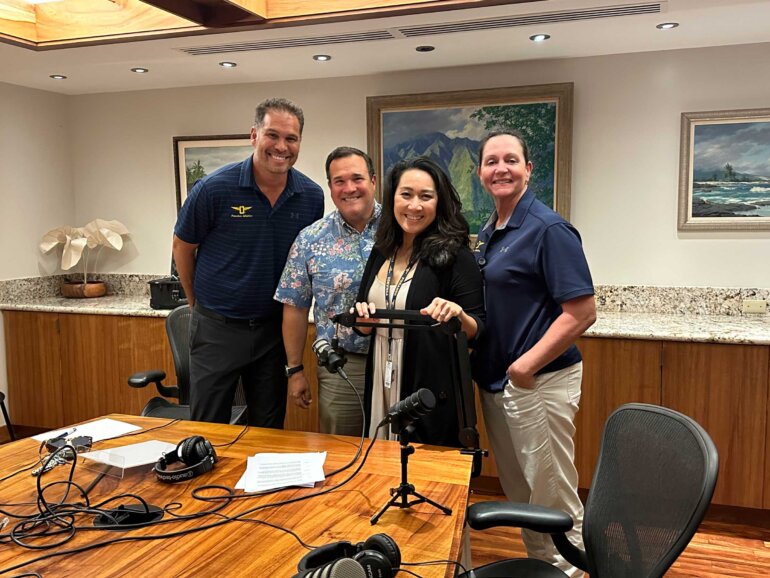In our ongoing “Listen and Learn” podcast series, Director of Enrollment Management and Admissions at Punahou School, Maile Uohara, spoke with Athletic Directors Rick Tune ’93 and Michelle Arnold, and Associate Principal for Student Life K – 12 James Kakos.
Each “Listen and Learn” podcast aims to provide valuable information and insights about our school and programs for prospective families. In each episode, we’ll be inviting guests from our school community to share their knowledge and experiences with our listeners.
You can find Punahou’s Team Up podcast on Apple Podcasts, Spotify, Simplecast and Google Play.
Podcast Transcript
Maile Uohara: Aloha, my name is Maile Uohara and I’m the Director of Enrollment Management and Admissions at Punahou School. I’d like to welcome you to our Listen and Learn podcast where we aim to provide valuable information and insights about our school and programs. In each episode, we’ll be inviting guests from our school community to share their knowledge and experience with our listeners.
Today, I’m delighted to have you meet Mr. James Kakos, our Associate Principal for Kindergarten through 12th grade student life and two of our athletic directors, Mr. Rick Tune and Ms. Michelle Arnold. James, Rick and Michelle, welcome to our Listen and Learn podcast. I’d love it if you could share a little bit about yourself and the roles you play within the athletics department.
James Kakos: Thanks, Maile. Hello, everyone. Again, my name is James Kakos and I am the Associate Principal for K – 12 Student Life. I have oversight of the athletic department and specifically the athletic directors. Beyond that, I work very closely with the deans on all aspects of student safety and I also work closely with extended learning programs.
Michelle Arnold: Aloha Kakou, my name is Michelle Arnold. Like Maile said, I’m one of the three athletic directors here at Punahou. I’m coming up. up on my seventh year at Punahou. First started in 2016 as an athletics associate. Couple years in that position, then became the director of athletic performance. And then most recently, where I serve now as an athletic director, this is my second year serving as AD.
Rick Tune: My name’s Rick Tune. I am in my 24th year serving at Punahou School after graduating in 1993. That’ll date yourself a little bit there. I started off as a full-time Academy substitute at Punahou School in 2000. And since then, I’ve had many roles ranging from high school counselor, to Academy Dean, to athletics associate, and now in my third year as athletic director.
Maile: Fantastic, the breadth and scope of experiences that you guys have had at Punahou is amazing and I think that really speaks volumes to what we’re gonna talk about today, which is about our student athletes and the care that we have for them. But to kick it off, James, I would love it if you could share with our listeners the scale and the scope of our athletic department and the programs that we actually offer.
James: Sure, so as far as we can tell, we are the largest independent school athletics program in the nation with 146 different teams, 21 sports programs, and give or take 470 coaches. So most of those coaches – about 90% are seasonal and part-time. And so it raises this question, right? How do we equip them to be not only coaches, but educators? And that’s a big part of my job. And so we started this “coach as educator” model, where we equip our coaches with all of the tools, all of the resources, the professional development and the training that our faculty have, right? So we have this very large program with a number of coaches that are spending more time with our student athletes on any given day, maybe like say two to three hours versus an hour of say a faculty member. So they have a huge impact on our student athletes. So it’s my job and the job of the athletic directors amongst other things to make sure that they are great teachers. The other thing about the scale of our program is that it allows for an emphasis on both participation as well as excellence. That’s why we carry so many different teams.



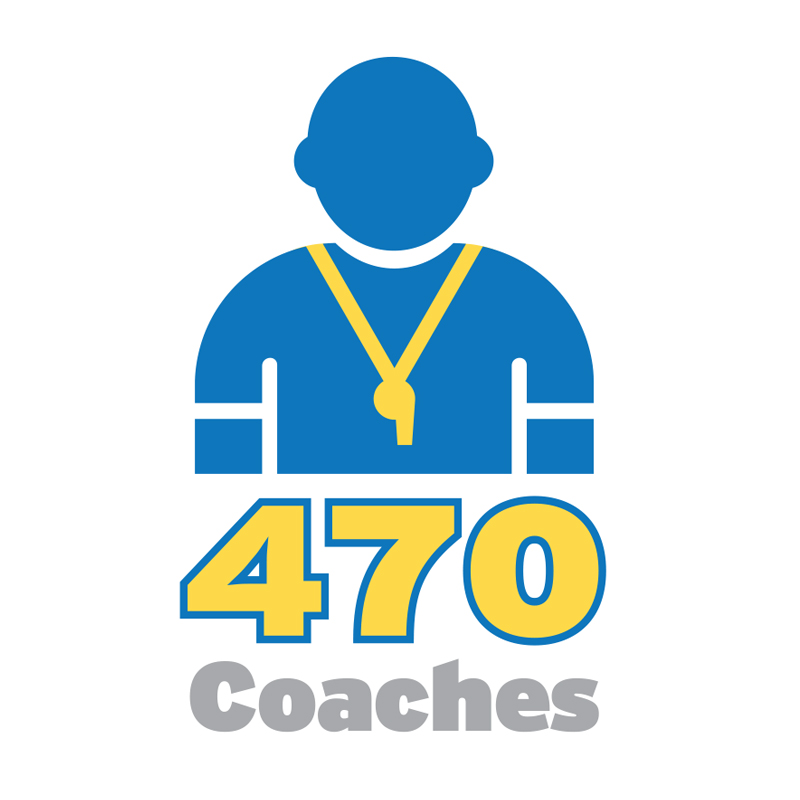
Maile: Wow, that’s just amazing to think about. I mean, I think you lost me at the beginning there when you just started throwing out the numbers and I was like trying to calculate that out and just the impact that the number of students that we’re serving and just the number of adults that, you know, our students are interacting with and and I love that we take that perspective of responsibility that we have of training all of these coaches and adults that will be part of these students’ lives.
Maile: Rick, I would love it if you could talk about the various levels and options that we have for these students when they’re exploring sports activities at different levels at our school, whether it’s an elementary school, or middle school, or even now at the high school level.
Rick: Yeah. I would love to take that question. And so another way that we show tremendous alignment with our school is in the way we structure our course offerings. So if we can take one course like volleyball, we take boys volleyball, for example, we have seven different teams within our boys volleyball program.
Maile: Seven? Wow.
Rick: We have an intermediate white team which participates in the division. Division II ILH League. We have an intermediate blue and an intermediate gold which participate in the Division I League. We have a JV blue and gold which participates in Division I League. A Varsity 1AA, which is in the Division II League, and then a Vars I, which participates in the Division I League.
Now, the differences are this. like, so if we think about the volleyball program laid out, we liken it to like the physics program, right? So in physics, if you enter physics in the academy, you have intro to physics, you have physics honors, you have AP physics one, AP physics one and two, AP physics C, and you can do all these different tracks depending on how much of a deep dive you want to do in physics. And we have the same kind of tracks in our boys volleyball and our other sports programs. So our intro to volleyball would really be our intermediate white program. And then for our seventh and eighth graders who are a little bit more advanced, not starting off, don’t want to dip their toes in the water and see what volleyball is about that are fully in it, then we have our blue and our gold teams.
Maile: So what I’m hearing is we’re really meeting the different levels of where our students are and providing them with those opportunities.
Rick: It’s differentiated learning, right, at its best in an athletic setting, really, right? And then by the time you work your way up to varsity, our varsity 1AA team is really geared towards those who really love the sport but don’t want to be making the time commitment and investment to do that at the level that it takes to do the varsity one team. And our varsity one team is really our AP volleyball class. So if you’re doing that class, you know that you’re gonna have to make sacrifices to maybe not do things like holokū and other experiences on campus, because you’re going to be fully immersed in an exceptional experience, but you’re going to make the time. commitment and the emotional investment to do volleyball.
Maile: I think what I love about Punahou and the way that we care for the student athlete is everything to what you had just said about the differentiated learning opportunities for the students, but especially once they get into the academy, it’s also just a structure of their day that we’re really allowing them to have or achieve balance. because of the way that even the school schedule is set up for them.
Rick: Yeah, it allows us to get in that zone of proximal development, right? Where a kid is being pushed, but not overwhelmed and being challenged and not just being allowed to coast, right? We really can place them in the level that is appropriately best for their development and to get them in that zone of proximal development. to really have them have success and make sure that they’re challenged and pushed along the way.
Maile: And it’s not unusual too that we have student athletes that are multi-sport too.
Rick: Absolutely.
Maile: So either Rick or James, I’m not sure who wants to take this question here, but for some of our students and parents, we get caught up in the Windsor losses and that’s very easy to do. But I know that we take this very holistic approach to this especially when it comes to the care of our students. I’d really love to hear the top three things you want our listeners to know about how we care for our student ethics? I think we’ve just touched upon it a little but if you could dive into it a little bit more
Rick: Yeah, I’m happy to take that one as well. So, you know when we talk about student athlete care, it really is about creating the conditions to optimize our students having success in their classroom, which is on the courts and in the fields and in the pool, right? And so I think if I were to say our top three priorities, number one is always student safety. And whatever they’re doing, we want to make sure that we have everything that they need to do it safely, right? So when we go to the beach for canoe paddling or kayaking, we have lifeguards, certified lifeguards that are there making sure that the activity is safe. We have a team of trainers that make sure that our kids are going through all the appropriate checks to go back and re-enter athletic competition in a safe and healthy way. Right. We have our coaches do more certifications than any of our full-time faculty members. Right?
Maile: What do those certifications look like when you say that they’re doing more?
Rick: Yeah, so all of our faculty members do all of the regular certifications, so do our coaches. In addition, our coaches take all the NFHS courses on concussion, heat management, right, ACPR, AED, yeah. So all of those courses are layered on to all the courses that are already required for all Punahou employees.
Maile: And I think what’s amazing about that is when we speak back to what James said, the volume, the number of coaches that we are putting through this training and really that safety and care for that athlete is of most importance to us.
Rick: Yeah, we have a rock star staff. Our admin assistant team in the front of the house processes all of these coaches with all of these certifications year-round right right so we want to give a shout out to them in this.
James: You know it makes me think about another step that we’ve taken at our seasonal coaches introduction meetings we we have guest speakers from different departments around our campus so recently we’ve had our school counselors come and speak about mental health, mental health awareness with our coaches and what to do and who to refer to if you have a concern. We also just had our information technology staff come and speak to our coaches about safe and appropriate channels of communication, electronic communication with our student athletes and with our families.
Maile: So that’s just amazing to me. What I’m hearing is that the care that you’re giving and the professional development that you’re providing to the coaches really translates into that experience that our students are having, right? And that we are taking them to that next level in terms of that athletic performance and development that we’re able to offer them.
Now, Michelle, I’ve had an opportunity to learn from you and see the amazing athletic performance center that we have. Now, in the absence of our families, being able to see it because we’re not taking them on a tour right now, I would love it if you could talk about our performance center and how it’s more than just a weight room or a fitness center. Because I know that you poured your heart and soul into building out what that center looks like. So I would love it if you could talk about the advantages that we have built-in for our athletes by having this center.

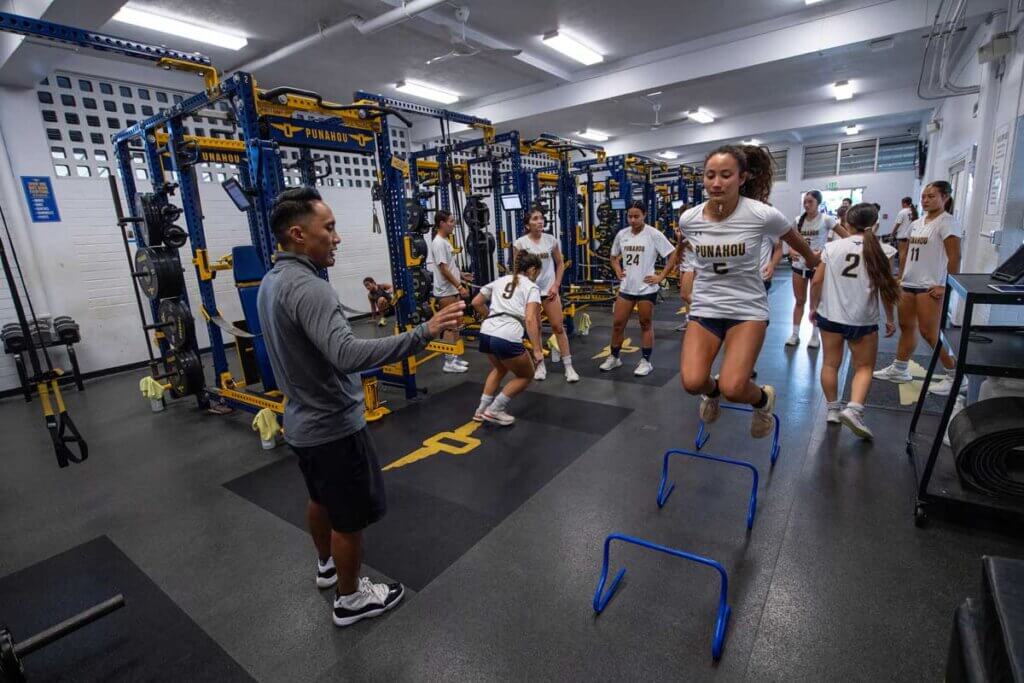
Michelle: Yeah, and you know, Maile, before we kind of get into that, I think the transformation and the renovation and the new approach we took to training really does keep our student athlete at the center of this, right? This all took place so that we could better care for them, we could better prepare them. So back in 2018, after about a year and a half of doing research going throughout the country, whether it was, was Division I NCAA programs, other independent schools across the country, taking a look at what kind of facilities they had, what kind of approaches they were taking to training, right, to strengthen conditioning. In 2018, we went ahead, pulled the trigger in and really went through a significant renovation. We actually gutted the entire space that was first filled with wall-to-wall, right? Single joint, selectorized weight training machines. There was some cardio equipment in there, but not a whole lot of room for movement. And so through our findings as we went and researched all of these performance programs, at the root of all of this was the best care for student athletes was creating excellent movement patterns. And so that kind of is what drove how we reimagined the space. So now when you go in there, instead of seeing, you know, these machines where you sit and you kind of do a shoulder press, or you go and you do a leg extension, now you’re going to see as soon as you walk in seven base camp racks. This is where we can do everything from Olympic lifting to deadlifting to bench pressing to lap pull, all on one rack. We have a dumbbell area that creates a lot of space, so now our kids can really treat their bodies or we can train our kids or our athletes to move and use their bodies as one integrated unit versus just individualized select parts of the body. So you’ll see a lot of open space where we can train our kids. can not only have our kids move more, but now we can do team training. Now we can get PE classes in there, one to two PE classes in there, training together, learning similar movements, if not the same movements, understanding that everything is based on the five pillars of human movement that both our athletic performance team and our PE department, you know, that we came up with these four pillars that kind of really root our movement, right? And root our training philosophy in these five pillars. So you’re gonna see that throughout, not just athletics, but the school day as well.
Maile: So when you say the five pillars, what are the five pillars?
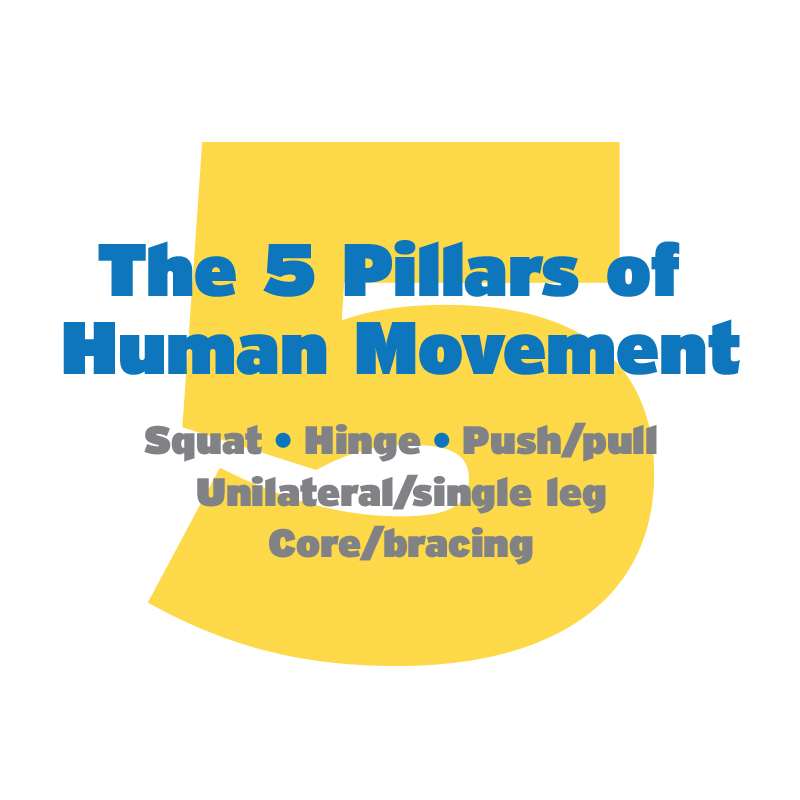
Michelle: So we have a push and pull, that’s one, whether it’s upper body, lower body, right? We have a single leg or single joint. And so, we’re looking at, you know, more… unilateral training. We have core or stability. We also call it bracing. So really understanding that at the core of your body, this is where a lot of your power will be generated from. So you have the push-pull, you have the core or the stability and bracing. We also, we look at, well this is actually one of the hardest ones to teach, but the most important is the hinge. And the hinge is really engaging our hips, right, to create more dynamic movement. And then we have the squat, right? So those five pillars of human movement, we start teaching as early as sixth grade, in PE class. And then when the kids come to us, like Rick talked about and James talked about at our intermediate level. right? We get teams training in there from the intermediate level, they already know what to do. They already know the definition of a squat, a hinge, what push-pull is. They understand how to read a workout. They understand why we’re doing certain things, right, as it pertains to maybe human functional movement in a PE class or what they need to, or what they need to train, right, to get ready for their sport or their competition.
Maile: I feel like all adults, including myself, need to improve on many of those things, the hinge, you know? But I think what I love when you talk about it and the perspective that we’ve taken on this is that it’s not just about student-athletes at this, right? It’s in the PE class, so it’s all of our students at some point will be exposed to this, regardless if they’re gonna become student-athletes within the Punahou ecosystem later on. It’s like… they’re just learning these fundamentals that hopefully down the line, somewhere in their life, they’ll be able to use it or understand it.
Michelle: Absolutely, and you know, when we were looking at redesigning the facility or renovating the facility, we had this with everyone in mind, right? From your blue chip athlete to your intermediate athlete to a sixth grader coming in to learn how to use the ladders that we have on the turf, you know, and we have equipment in there that really is adaptable or appropriate for training age. So, you know, it was fun to do that with our PE department and go and look for equipment and see how we could design a facility that really kind of hit a home run for everyone.
Maile: And I think what’s exciting about that. that is that I was talking to another podcast with Dr. Rebecca Wagner and we just talked about the love of learning. And I think the way that we set it up here, we’re exposing them in PE class is you can spark an interest and you don’t know where it’s gonna lead, right? It could lead to them becoming or being interested in other types of sports here or just taking away that fear for when they’re in college or as an adult when they walk into a new gym or something like that, like, oh, I know how to do this, right, and that’s all that they need. So it’s really encouraging to me that we’re not only just serving our athletes, but all students from 6 – 12 through this facility here.
I’d like to touch upon sports medicine and the intersection that our programs have with this. I would love it if one of you could speak to how we take a data-driven approach to caring for our students and how that has resulted in less injuries.
Michelle: So right after we renovated the weight room, right? So this was, I believe, when we came out of COVID, we really took a look at, okay, we have the facility, the training philosophy has switched, we have PE dialed in, what’s our next step? And it was really involving or incorporating more science to this. So the first iteration of this sports science component that we added to performance took place in school year 2021. And the athletic performance staff partnered with SportsMed and we did an assessment, right? I think it was with the football team boys and girls volleyball boys and girls soccer boys and girls basketball and we really looked at how our kids were moving and through assessing these kids through this optimal performance screen we were able to identify vulnerabilities in our athletes and wherever we saw these vulnerability or these deficiencies we were able to take that data talk with sports med would talk with our athletic performance team and we would throw in or kind of sprinkle in correctives to address these deficiencies when they come to train with us right and so as a result the sports medicine department was able after that first year was able to look at Punahou’s historical data compared compare it to the injuries that were occurring after we did this optimal performance screen. And I have a few data points to share.
After that first year, the varsity baseball team saw their injuries decrease by about 25 % after just one year. The varsity football team saw their head, neck, knee, and shoulder injuries. Most common in football, right? That decreased by 50 percent. The varsity JV boys and girls wrestling team, they saw their injuries also decreased by about 50 percent. So it was exciting, right? We’re like, OK, we’re really kind of zeroing, zeroing in on our kids, seeing or identifying where we could get better, where we could help them the most, right? And so as a result, we’re at a point now where we’re incorporating more sports medicine every year. In fact, next year, we’re going to bring in a whole bunch of technology, namely four-stacks, to really kind of better assess our kids and to better address those deficiencies. Whatever the program’s going to, you know, identify as deficiencies, we’re going to address through training.
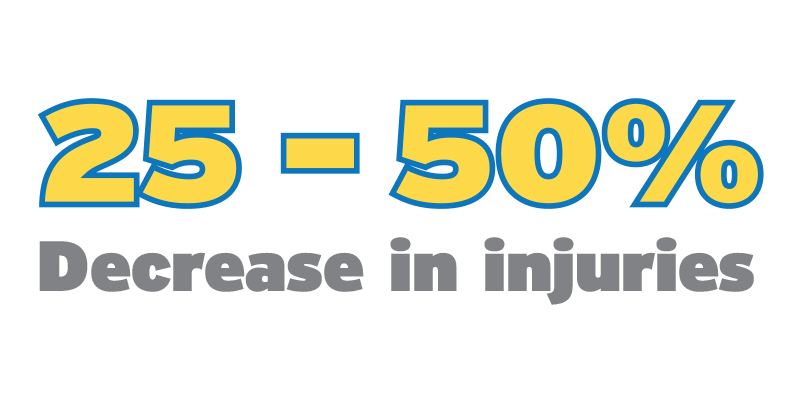
Maile: And I know, Rick, I heard you in another presentation where you were talking about I think for some of our athletes that graduate and they go on to colleges, they’re finding that what we’re able to provide them and the foundations is even more so than what they find at some of these, even colleges or universities too.
Rick: Absolutely, 100%. The things that Michelle is talking about in terms of sports science really, it’s this merge of all the data that you collect on a student-athlete recovery, sleep patterns, how much you’re working them, how you’re addressing their care and recovery. All of that data comes into one dashboard and you’re able to provide coaches with more realtime information about how to train and optimize their training for their competitions.
Maile: And not overtrain or overwork. And not overtrain, correct.
Rick: And in this day and age with clubs and everything. you know going year round it really is an issue. We see more overuse injuries now than ever before in our student athletes.
Maile: It was just on the news today talking about youth athletes and overtraining.
James: I think a big part of Michelle’s approach with the performance center and sports science is a notion of periodization that really when you’re looking at the training year round, rest and recovery, right? Lowering your load are so relevant. It’s not just about bigger, faster, stronger. It’s about recovery so you don’t get those overuse injuries. And so for each of our sports, Michelle and her team are putting together a periodized yearlong program to avoid those sorts of injuries.
Maile: That’s amazing because I think it makes stronger athletes in the end, but also ones that are well rested in between appropriately rested, I should say. So James, you know, we’ve talked about a lot and it’s been really exciting, but I would like you to comment on what are the few things, let’s maybe do three things that you are most proud of when you think about the athletic program and where we are today.
James: Athletics is a platform for lifelong skills. And I’m proud of the fact that we’re doing our best to maximize that platform through the programs you heard about today. It makes me think about a survey we gave to our alums about what about Punahou best prepared you for life after you leave the school? And it was a narrative response, right? So the more times a word was written by an alum, it was bigger in the wordle. So you see Punahou and number two, you saw athletics. And that’s not an accident. I was recently interviewed for an article about athletics in the bulletin. And I made the comment that the wins and losses fade, right? But it’s the relationships, it’s the life lessons. Those are the things that our student athletes will have for life and for me the very proudest moments I have are when those athletes return back to Punahou and they share those life experiences and that gratitude with us.
Maile: That’s amazing. I’m really excited about this podcast and can’t wait for our listeners to hear because I think we have a phenomenal athletics department, obviously led by phenomenal athletic directors. I love the vision that you have for student care, student athletes and that we are not only serving them but all students within our school to make them better appropriately where they are athletes themselves. So thank you so much for joining me today, I really appreciate it.

